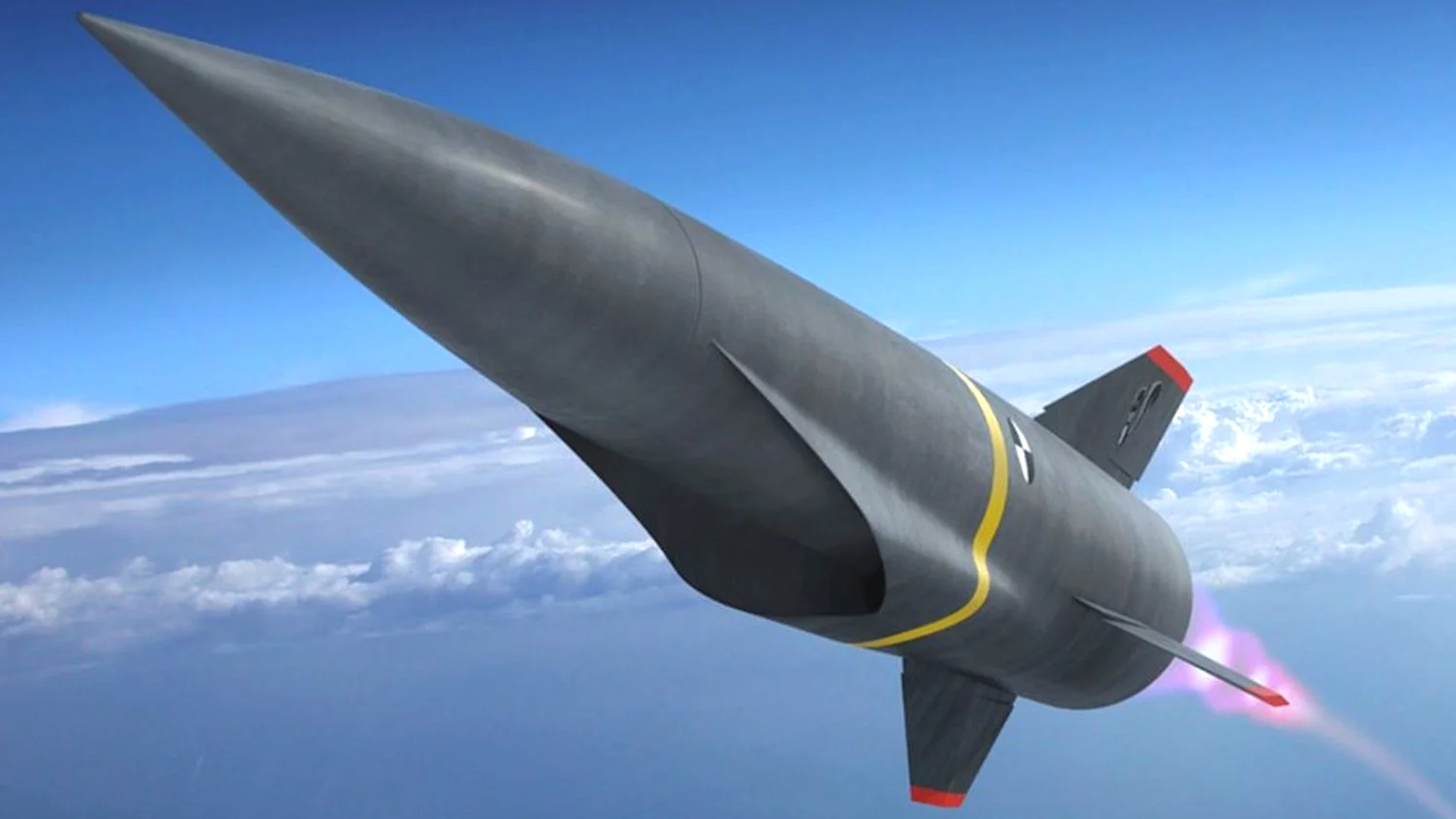The U.S. Navy says it needs to field an air-launched air-breathing hypersonic anti-ship cruise missile no later than 2028. The service says this weapon is essential to help it counter emerging threats from potential near-peer adversaries, such as China and Russia.
Details about what the Navy is now formally calling the Hypersonic Air-Launched Offensive Anti-Surface Warfare missile, or HALO, are contained in recently released documents related to the service’s latest budget request for the 2023 Fiscal Year. This program was previously known as Offensive Anti-Surface Warfare Increment 2 (OASuW Inc 2). OASuW Increment 1 is the existing AGM-158C Long-Range Anti-Ship Missile (LRASM), a subsonic design.
“OASuW Inc 2/HALO will address advanced threats from engagement distances that allow the Navy to operate in, and control, contested battle space in littoral waters and Anti-Access/Area Denial (A2/AD) environments,” one budget document says. “In order to counter the evolving near-peer threat capability, OASuW Inc 2/HALO is required to be fielded in FY 2028.”
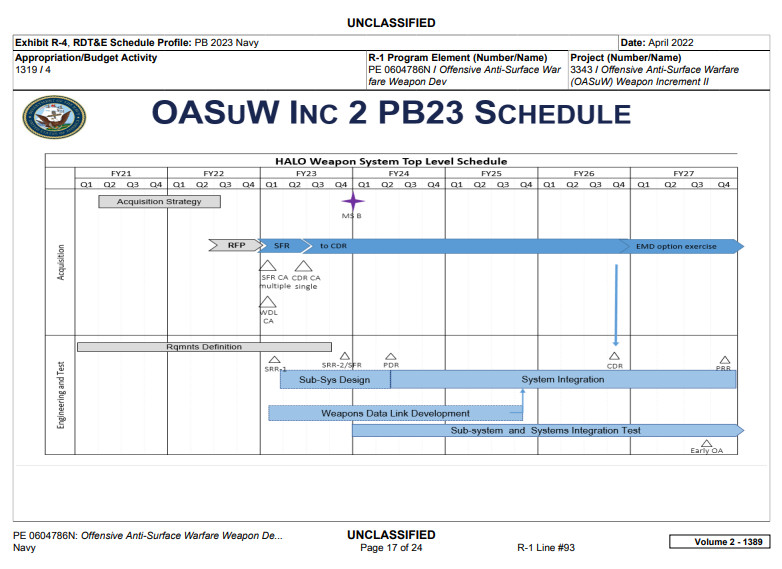
The Navy is seeking just under $92.5 million to get the HALO program going in the 2023 Fiscal Year. The service says that funding will go toward things like initiating a new technology development program for the missile, making “targeted investments in maturing subsystem technologies,” and “component or full-scale prototyping activities.” The latter work would support the development of a datalink for the weapon, among other things.
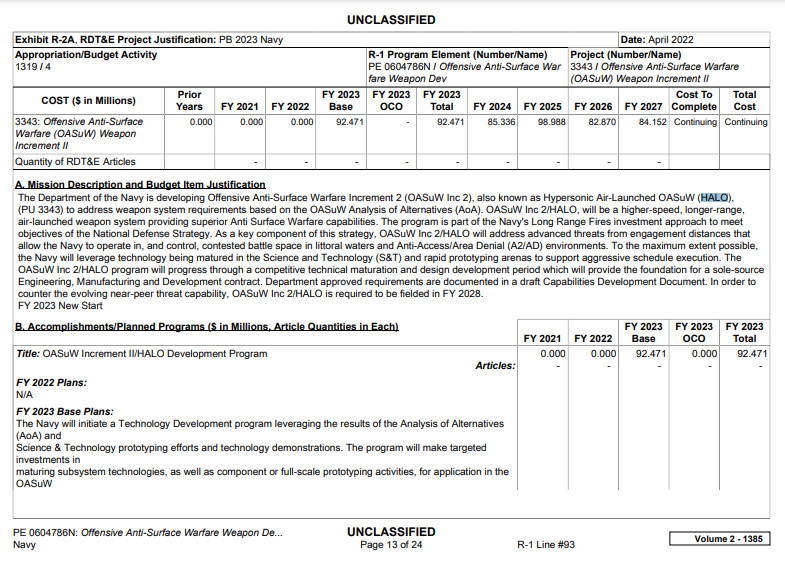
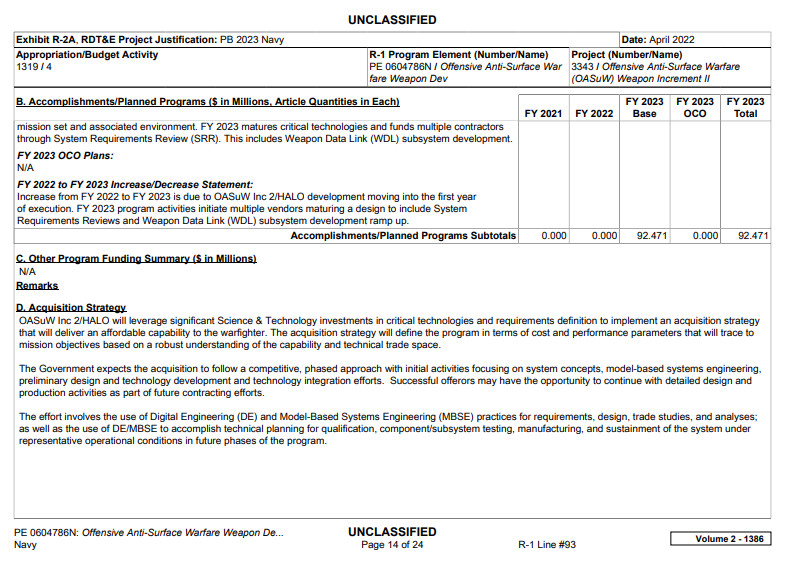
The budget documents do not include any specific details about the desired configuration, performance, and other capabilities of the HALO missile before the mention of an integrated datalink. That would enable the weapon to receive new targeting information throughout the course of its flight, or even be retargeted entirely, as well as potentially send back various kinds of information and work with other missiles. The Navy does say that it will leverage relevant, but unspecified previous work.
In March 2021, the Office of Naval Research did issue a contracting notice regarding the planned develop an experimental scramjet-powered hypersonic anti-ship cruise missile design that would be compatible with the F/A-18E/F Super Hornet fighter jet, dubbed Screaming Arrow, before canceling it just days later for unclear reasons. It subsequently re-issued the notice in August.
The year before, the Navy had hired Boeing to develop a ramjet-powered missile demonstrator to refine for future high-speed air-launched anti-ship and land-attack missiles for its F/A-18E/Fs. The Navy has also been directly involved in the past in at least one other U.S. Air Force-led experimental air-launched hypersonic missile program, which was conducted under the auspices of the Pentagon’s Joint Hypersonics Transition Office (JHTO). Boeing was the prime contractor in that case, as well, with a design known as HyFly 2 that was intended to provide a stepping-stone to an operational capability for the Super Hornet.
There has been no shortage of other air-breathing hypersonic weapon programs within the Department of Defense in recent years that the Navy could seek to leverage, as well. This includes a U.S.-Australian partnership, again related to the development of an air-launched hypersonic missile that would be compatible with the F/A-18E/F design, and the Defense Advanced Research Projects Agency’s (DARPA) Hypersonic Air-breathing Weapon Concept (HAWC) project. HAWC, which the Air Force is also participating in, is supposed to be a stepping stone to that service’s Hypersonic Attack Cruise Missile (HACM) program, which it hopes will produce an operational weapon in the 2027 timeframe.
The Navy’s Fiscal Year 2023 budget proposal does not name any specific desired launch platforms for HALO, but it would seem that it is most interested in integrating this weapon first on its Super Hornets based on its past work. This missile could eventually be integrated onto other Navy aircraft, such as the F-35C Joint Strike Fighter, but the design could easily be too large to fit inside that aircraft’s internal weapons bays. Lockheed Martin has previously released artwork of an F-35C carrying a missile based on its HAWC design externally, which would negatively impact the jet’s stealthy characteristics.
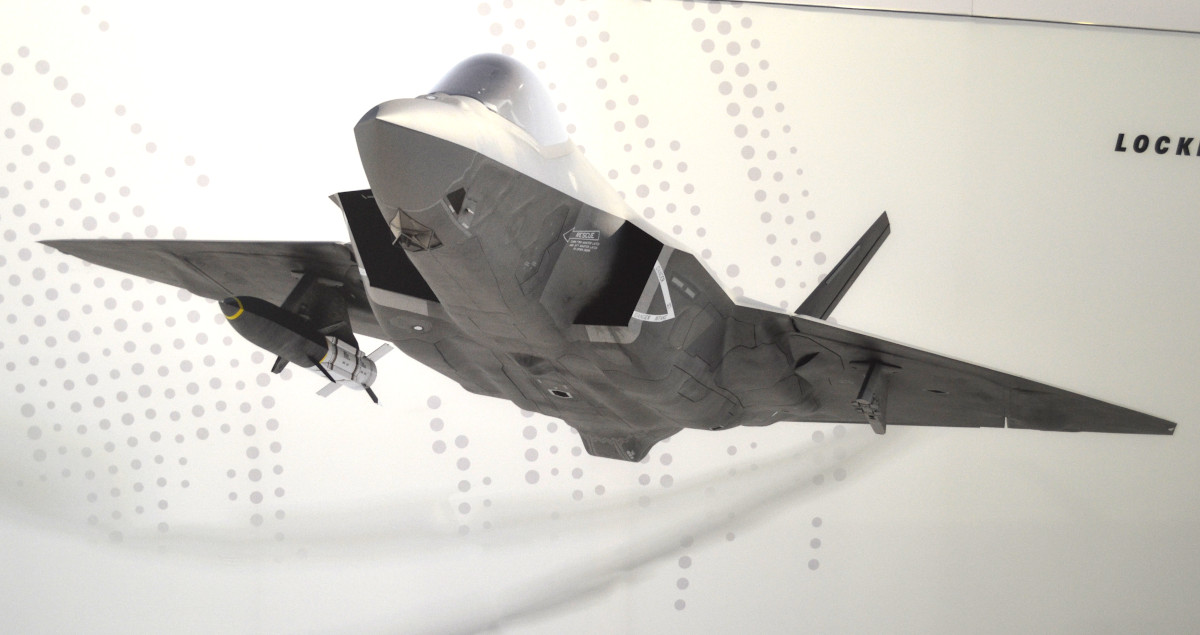
In addition, while the Navy’s immediate goal is clearly to acquire hypersonic anti-ship cruise missile, it is very possible that the final HALO design could also have a land-attack capability. It’s worth noting that the Navy is separately working to acquire a service-specific subvariant of the AGM-158C, the AGM-158C-3, that will blend LRASM’s capabilities with those of the latest versions of its parent design, the AGM-158 Joint Air-to-Surface Standoff Missile (JASSM), and subsequently be able to strike targets on land, as well as ashore.
Regardless, the Navy’s 2023 Fiscal Year budget proposal makes it clear that the service views HALO as essential to assuring its ability to conduct aerial stand-off strikes at extended ranges against major threats in highly contested environments in any future high-end conflict. Though the budget documents do not specifically name the “evolving near-peer threat capability” that driving the Navy to field this weapon within the next six years, Russia claims to be working toward fielding its own ship-launched air-breathing hypersonic cruise missile, the Zircon. China is pushing ahead in its own development and fielding of high-speed anti-ship cruise missiles and anti-ship ballistic missiles.
HALO is just the latest addition to the Navy’s plans to field various hypersonic missiles of various types within the next decade. This includes the Intermediate-Range Conventional Prompt Strike (IRCPS) missile, which the service is developing together with the Army and that carries an unpowered hypersonic boost-glide vehicle, and the Standard Missile 6 (SM-6) Block IB. IRCPS, which the Navy hopes to deploy first in 2025 on its Zumwalt class stealth destroyers, is intended primarily as a way to strike high-value, heavily defended, and potentially time-sensitive targets ashore. The Navy hopes to field the SM-6 Block IB, a multi-purpose weapon that will be capable of engaging various targets at sea, on land, and in the air, as a new weapon for various classes of ships and submarines in 2027.
With the Navy now aiming for an aggressive development schedule for the air-launched HALO missile, it could potentially have three different new hypersonic missiles in service by the end of the decade.
Contact the author: joe@thedrive.com
